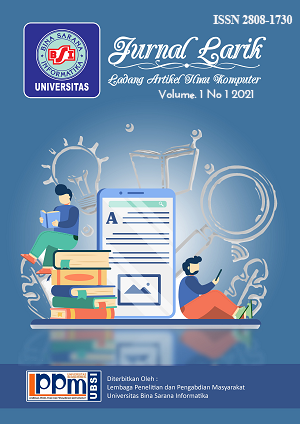PENERAPAN ALGORITMA NAÏVE BAYES UNTUK MEMPREDIKSI GEJALA DEMAM TIFOID PADA PUSKESMAS CIBADAK
DOI:
https://doi.org/10.31294/larik.v1i1.499Keywords:
Naïve Bayes Classifier, Data Mining, Demam TifoidAbstract
Typhoid fever is an infectious disease that is still a health problem in developing countries, especially in Indonesia. Salmonella typhi is a bacterium that causes typhoid fever which can be transmitted through food or drink contaminated by feces or urine from an infected person. The first step in managing typhoid fever is determining the right diagnosis. To reduce detection errors and avoid delays in diagnosis of typhoid fever sufferers, the application and utilization of data mining techniques can be carried out. One of the algorithms that can be applied is Naive Bayes Classifier, with the implementation of the Naive Bayes Classifier algorithm it is expected that sufferers can find out their health condition from typhoid fever that may occur, so they can immediately take action in an effort to minimize the symptoms that occur and are expected to take action early on. this makes other symptoms that will occur just do not occur and the symptoms are reduced. The Naïve Bayes Classifier is a well-known classification model and is often used. The results of this study get an accuracy of 93.71%. using rapid miner 5.2 with 142 datasets.References
Purba, Y. P., & Ramadhian, M. R. (2019). Efektivitas Antibakteri Ekstrak Etanol Mentimun ( Cucumis sativus L .) terhadap Pertumbuhan Salmonella typhi Antibacterial Effectiveness of Cucumber ( Cucumis sativus L .) Ethanol Extract on Salmonella typhi Growth. 8, 144–149.
Hartono, D., Somantri, Iwan., Februanti, Sopia. (2019). Hipnosis Lima Jari dengan Pendekatan Spiritual Menurunkan Insomnia pada Lansia Jurnal Kesehatan, 187-192
Kustiyahningsih, Y., & Rahmanita, E. (2016). Aplikasi Sistem Pendukung Keputusan Menggunakan Algoritma C4.5. untuk Penjurusan SMA. Jurnal Semantec, 5(2), 101–108.
Wafiyah Fakihatin, Hidayat Nurul, P. R. S. (2017). Implementasi Algoritma Modified K-Nearest Neighbor ( MKNN ) untuk Klasifikasi Penyakit Demam. Jurnal Pengembangan Teknologi Informasi Dan Ilmu Komputer (J-PTIIK) Universitas Brawijaya, 1(10), 1210–1219
Kumara, R., & Supriyanto, C. (2014). Klasifikasi Data Mining Untuk Penerimaan Seleksi Calon Pegawai Negeri Sipil 2014 Menggunakan Algoritma Decision Tree C4.5. 1–10.
Haryanto, F. F., & Hansun, S. (2017). Penerapan Algoritma C4.5 untuk Memprediksi Penerimaan Calon Pegawai Baru di PT WISE. Jurnal Teknik Informatika Dan Sistem Informasi, 3(2), 95–103. Retrieved from http://jurnal.mdp.ac.id/index.php/jatisi/article/view/71
Brian, T. (2016). ANALISIS LEARNING RATES PADA ALGORITMA BACKPROPAGATION UNTUK KLASIFIKASI PENYAKIT DIABETES. 3(1), 21–27.
Setiawan, T. A., Satria, R., Syukur, A., Komputer, F. I., & Nuswantoro, U. D. (2015). Integrasi Metode Sample Bootstrapping dan Weighted Principal Component Analysis untuk Meningkatkan Performa K Nearest Neighbor pada Dataset Besar. Journal of Intelligent Systems, 1(2), 76–81.
Sumpena, J., & H, N. K. (2019). Analisis prediksi kelulusan siswa pkbm paket c dengan metoda algoritma naïve beyes. 13(2), 127–133.
A. Saleh, “Implementasi Metode Klasifikasi Naïve Bayes Dalam Memprediksi Besarnya Penggunaan Listrik Rumah Tangga,” vol. 2, no. 3, pp. 207–217, 2015




